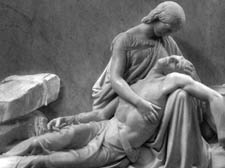
the memorial to Mary and Percy Bysshe Shelley in Christchurch Priory in Dorset |
A half life lost inside
the Shelley closed circle
Ann Wroe finds herself absorbed by the story of a largely forgotten and overlooked member of
Shelley’s family, Fanny Wollstonecraft
Death and the Maidens – Fanny Wollstonecraft and the Shelley Circle.
By Janet Todd. Profile Books £17.99 order this book
POOR Fanny Wollstonecraft. We don’t even know what she looked like; only the off-hand remarks of other people tell us that she was plain, red-faced when cross, and scarred by smallpox. In the famously intellectual and scandalous circle of the Godwins and the Shelleys, she was the little mouse in the corner, barely noticed and, when she squeaked, suppressed.
Fanny grew up in a household where she only half belonged. Her father was an American adventurer who loved her mother and left; she never knew him. Her mother, Mary Wollstonecraft, was famous for being the author of A Vindication of the Rights of Woman, but she died in 1797 when Fanny was still small, and her fierce rebel intelligence was not passed on.
Fanny had some interest in social issues and the rights of the poor; but by nature she was a subservient, dutiful soul. As the stepdaughter of William Godwin, the radical philosopher, she endeavoured dutifully to keep the family together in their constant crises over money. As stepsister to Mary Godwin, she was drawn pell-mell into the circle of very young women who hovered, adoring, round the poet Percy Bysshe Shelley.
She probably loved him too; and it destroyed her.
With so many stars crashing in and out of her firmament, it is no wonder that biographers have paid no attention to Fanny in the past. Janet Todd, a professor of English at the University of Aberdeen, makes up that deficiency with a tender, simply written, deeply sympathetic book.
It could have been longer; for by the end the reader is so firmly on Fanny’s side that, when we’re told of letters written by her, we suddenly want an appendix giving every word of them, so that we can hear the voice no one else seemed to have an interest in.
The arrival of Shelley as a regular visitor to the Godwin household, from the early summer of 1814, was probably the most important event in Fanny’s life. His letters to Godwin, discussing radical philosophy, had been coming since 1812; that December Fanny had dared to write to him herself, though wondering timidly whether it was “proper” to do so: “I am one of those formidable and long-clawed animals called a Man”, he wrote back to her.
When he appeared, tall, wild-eyed, aristocratic and full of passionate enthusiasm, the whole household fell under the spell of this “cult of genius”, as Ms Todd describes it. But when Mary Godwin and Claire Clairmont, Fanny’s stepsisters, fled away with him to France, Fanny stayed. She always longed to join his roving, hectic households; but she was rebuffed.
Mary was actively unkind about Fanny; and Shelley, as so often, failed to notice the damage he was doing. He deeply regretted it afterwards; but by then it was too late. Fanny took her own life in October 1816, in Swansea, with an overdose of laudanum.
Tender to the last, Ms Todd notes that Fanny’s stockings were marked “G” and her stays “MW”, proving her ties even in death to the family that scarcely seemed to acknowledge her. Her name was even torn from her suicide note – by Shelley, Ms Todd thinks – to spare the Godwins any disgrace by association. And then the world forgot her.
|



